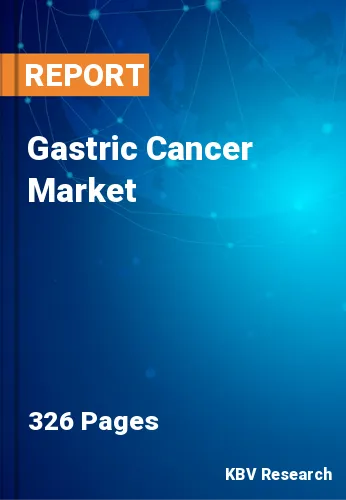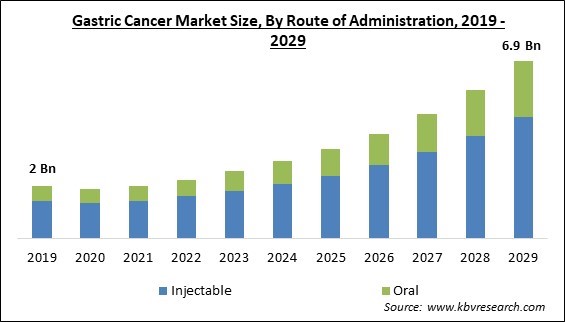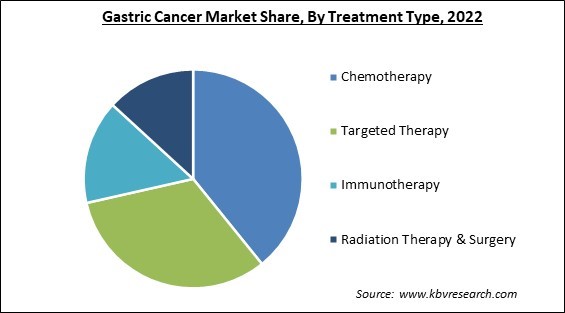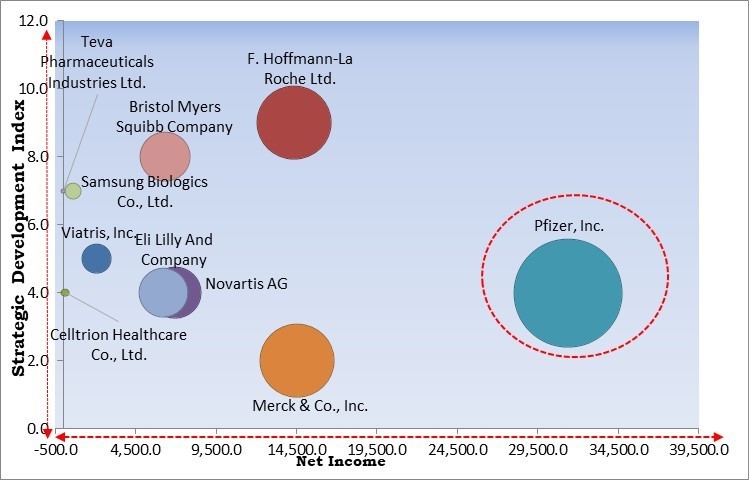
The Global Gastric Cancer Market size is expected to reach $6.9 billion by 2029, rising at a market growth of 17.6% CAGR during the forecast period.
The cells lining the stomach are where gastric cancer, also known as stomach cancer, first develops. Abdominal pain, vomiting, nausea, bloating, and weight loss can all be signs of gastric cancer. Surgery, radiation therapy, chemotherapy, or a combination of these treatments are all possible forms of treatment for gastric cancer.

Cancer develops when the body's cells start to proliferate out of control. Cancerous cells can develop in almost any body portion and spread to other organs. Usually, gastric cancers grow slowly over several decades. Precancerous alterations frequently appear in the inner mucosa of the stomach before genuine cancer develops. Since these early alterations rarely have symptoms, they may go unnoticed.
Different parts of the stomach can develop cancer at different times, which can result in a variety of symptoms and prognoses. Treatment choices may vary depending on the location of the cancer. For instance, malignancies that develop into or begin at the GE junction are often staged and treated similarly to esophageal tumors. The mucosa, the stomach's innermost lining, contains gland cells that give rise to these malignancies.
The intestinal type and diffuse type of stomach adenocarcinomas are the two basic forms. The likelihood of specific gene alterations in cancer cells increases the possibility that they can be treated with targeted medication therapy. The diffuse form typically spreads more rapidly. It is less frequent than the intestinal variety, and it is frequently more challenging to treat.
Delays in diagnosis & treatment have been the primary effects of the COVID-19 pandemic on gastric cancer. Delays in cancer diagnosis & treatment were the result, and they can significantly affect how patients turn out. Cancer research, particularly clinical trials looking at novel treatments for gastric cancer, has also been hampered by the pandemic. Due to COVID-19 limits, numerous clinical trials were postponed or suspended, which may be slowing down the creation of new treatments for the illness. However, the severe cases were being treated during the pandemic period. Considering these elements, the gastric cancer market witnessed a moderate impact due to COVID-19.
The number of targeted medications and immunotherapy treatments being developed and introduced into the market has increased due to a better understanding of the disease's molecular foundation. Since 2010, HER-2-specific medications, such as Herceptin, have been marketed. EGFR and PD-1 targeted therapy and immunotherapies are currently being created to treat gastric cancer. Furthermore, the market for gastric cancer is also anticipated to be driven by the approval and subsequent release of medications in the clinical pipeline aiding the gastric cancer market growth.
Gastric cancer is the most prevalent cancer type in Eastern Asia. 2020 saw an anticipated 1.1 million new cases of stomach cancer and 770 000 gastric cancer-related deaths, with male incidence rates often being twice as high as females. During the forecast period, it is anticipated that the rising prevalence of gastric carcinoma will increase demand for gastric cancer treatments and make them one of the most popular market trends for stomach cancer treatments. During the forecast period, this is expected to help the growth of the gastric cancer market.
Treating cancer using chemotherapy, radiation therapy, or a combination of the two with surgery is possible. The medications used in chemotherapy function by attacking rapidly dividing cancer cells; however, they can also harm healthy cells, resulting in unpleasant side effects such as nausea, vomiting, and exhaustion. In the next years, it is anticipated that this aspect will function as a barrier to the demand in the market. It is projected that factors such as high therapy costs and relatively limited availability of medications for the treatment of stomach cancer would work together to impede the growth of the gastric cancer market throughout the forecasted period.
Based on disease type, the gastric cancer market is characterized into adenocarcinoma, lymphoma, gastrointestinal stromal tumor, carcinoid tumor, and others. The lymphoma segment covered a considerable revenue share in the gastric cancer market in 2022. The immune system's lymphocytes are where these tumors develop in the first place. There are some lymphomas that can begin in the stomach wall, while most lymphomas begin in other areas of the body. Depending on the lymphoma type and other variables, these tumors can be treated and have good prognoses. The rising awareness of the lymphoma are predicted to support the segment’s expansion.

On the basis of treatment type, the gastric cancer market is classified into immunotherapy, targeted therapy, chemotherapy, and radiation therapy & surgery. The targeted therapy segment acquired a substantial revenue share in the gastric cancer market in 2022. With targeted therapy, cancer patients receive treatment by having pharmaceuticals that specifically target the genes or proteins that the cancer cells have. Targeted therapy for cancer comes in various forms, including hormonal treatments, gene expression regulators, angiogenesis inhibitors, apoptosis inducers, signal transduction inhibitors, and several more.
By drug class, the gastric cancer market is divided into PD-1/PD-L1 inhibitors, HER2 antagonists, VEGFR2 antagonists, and others. In 2022, the PD-1/PD-L1 inhibitors segment dominated the gastric cancer market with the maximum revenue share. Immune checkpoint proteins such as programmed cell death protein 1 (PD-1) and PD-L1 often aid in preventing overactive immune responses that may harm healthy tissues. For the treatment of severe or metastatic gastric cancer, a number of PD-1/PD-L1 inhibitors, such as nivolumab, pembrolizumab, and atezolizumab, have been licensed. In patients with advanced gastric cancer, several medications have demonstrated effectiveness in extending survival and slowing tumor growth.
Based on route of administration, the gastric cancer market is segmented into oral and injectable. In 2022, the injectable segment registered the maximum revenue share in the gastric cancer market. Since injectable pharmaceuticals are administered directly into the bloodstream, they can be absorbed faster than oral medicines. This helps individuals with advanced or metastatic stomach cancer, where quick action may be required. More of the drug can reach its target site when it is administered intravenously, which increases bioavailability. Less side effects and better therapeutic outcomes may arise from this.
On the basis of distribution channel, the gastric cancer market is classified into specialty & retail pharmacies, hospital pharmacies, and others. The hospital pharmacies segment projected a prominent revenue share in the gastric cancer market in 2022. The creation of government-sponsored hospitals pharmacies as well as advantageous reimbursement are the main causes of the hospital pharmacy segment's growth. These reasons together with the strong support the government has provided for cancer treatment. The segment is also predicted to expand as a result of the growing patient pool, growing prevalence of stomach cancer, and increasing number of cancer treatment facilities.
| Report Attribute | Details |
|---|---|
| Market size value in 2022 | USD 2.3 Billion |
| Market size forecast in 2029 | USD 6.9 Billion |
| Base Year | 2022 |
| Historical Period | 2019 to 2021 |
| Forecast Period | 2023 to 2029 |
| Revenue Growth Rate | CAGR of 17.6% from 2023 to 2029 |
| Number of Pages | 326 |
| Number of Table | 563 |
| Report coverage | Market Trends, Revenue Estimation and Forecast, Segmentation Analysis, Regional and Country Breakdown, Companies Strategic Developments, Company Profiling |
| Segments covered | Route of Administration, Treatment Type, Disease Type, Distribution Channel, Drug Class, Region |
| Country scope | US, Canada, Mexico, Germany, UK, France, Russia, Spain, Italy, China, Japan, India, South Korea, Singapore, Malaysia, Brazil, Argentina, UAE, Saudi Arabia, South Africa, Nigeria |
| Growth Drivers |
|
| Restraints |
|
Region wise, the gastric cancer market is analyzed across North America, Europe, Asia Pacific, and LAMEA. In 2022, the Asia Pacific region led the gastric cancer market by generating the largest revenue share. The expansion of the market is being driven by the rise in the geriatric population in the Asia-Pacific region. The demand for gastric cancer diagnostics has been driven by the prevalence of gastrointestinal tumors and lymphomas. Furthermore, the rising case of gastric cancer in the region is anticipated to propel the market growth in the Asia Pacific during the projected period.
Free Valuable Insights: Global Gastric Cancer Market size to reach USD 6.9 Billion by 2029

The major strategies followed by the market participants are Partnerships. Based on the Analysis presented in the Cardinal matrix; Pfizer, Inc. is the major forerunner in the Gastric Cancer Market. Companies such as Merck & Co., Inc., Teva Pharmaceutical Industries Ltd., Eli Lilly, and Company are some of the key innovators in Gastric Cancer Market.
The market research report covers the analysis of key stakeholders of the market. Key companies profiled in the report include Novartis AG, Pfizer, Inc., Viatris, Inc. (Mylan N.V.), F. Hoffmann-La Roche Ltd., Eli Lilly And Company, Merck & Co., Inc., Teva Pharmaceuticals Industries Ltd., Bristol Myers Squibb Company, Celltrion Healthcare Co., Ltd., and Samsung Biologics Co., Ltd. (Samsung Bioepis Co., Ltd.).
By Route of Administration
By Treatment Type
By Disease Type
By Distribution Channel
By Drug Class
By Geography
The Market size is projected to reach USD 6.9 billion by 2029.
Rising Prevalence of Gastric Cancer are driving the Market in coming years, however, Limited treatment option combined with their associated side effects restraints the growth of the Market.
Novartis AG, Pfizer, Inc., Viatris, Inc. (Mylan N.V.), F. Hoffmann-La Roche Ltd., Eli Lilly And Company, Merck & Co., Inc., Teva Pharmaceuticals Industries Ltd., Bristol Myers Squibb Company, Celltrion Healthcare Co., Ltd., and Samsung Biologics Co., Ltd. (Samsung Bioepis Co., Ltd.).
The expected CAGR of this Market is 17.6% from 2023 to 2029.
The Chemotherapy segment acquired maximum revenue share in the Global Gastric Cancer Market by Treatment Type in 2022 thereby, achieving a market value of $2.6 billion by 2029.
The Asia Pacific market dominated the Market by Region in 2022, and would continue to be a dominant market till 2029; thereby, achieving a market value of $2.6 billion by 2029.
Our team of dedicated experts can provide you with attractive expansion opportunities for your business.
